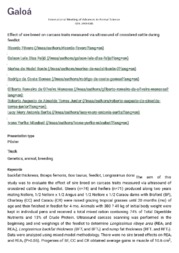Effect of sire breed on carcass traits measured via ultrasound of crossbred cattle during feedlot.
Effect of sire breed on carcass traits measured via ultrasound of crossbred cattle during feedlot.
Author(s): FAVERO, R.; FEIJO, G. L. D.; BONIN, M. N.; GOMES, R. da C.; MENEZES, G. R. de O.; TORRES JUNIOR, R. A. de A.; SURITTA, L. M. A.; MIZUBUTI, I. Y.
Summary: The aim of this study was to evaluate the effect of sire breed on carcass traits measured via ultrasound of crossbred cattle during feedlot. Steers (n=74) and heifers (n=71) produced along two years mating Nellore, ½ Nellore x ½ Angus and ½ Nellore x ½ Caracu dams with Braford (BF), Charbray (CC) and Caracu (CR) were raised grazing tropical grasses until 20 months (mo) of age and then finished in feedlot for 4 mo. Animals with 3 80 ± 49 kg of initial body eight were kept in individual pens and received a total mixed ration containing 74% of Total Digestible Nutrients and 13 % of Crude Protein . Ultrasound carcass scanning was performed in the beginning and end weighings of the feedlot to determine Longissimus ribeye area (REA i and REA f ), Longissimus backfat thickness (BFT i and BFT f ) and rump fat thickness (RFT i and RFT f ). Data were analyzed using mixed model methodology. There were no sire breed effects on REA i and REA f (P>0.05). Progenies of BF, CC and CR obtained average gains in muscle of 10.6 cm 2 , 12.2 cm 2 e 7.9 cm 2 , respectively. No differences (P>0.05) for BFT i and BFT f were found between progenies of BF (4.7 e 8.2 mm), CC 4.1 e 7.8 mm) and CR sires (4.4 e 7.7 mm). Sire breed did not influence on RFT i , however BF progenies had greater RFT f than CC progenies (11.3 vs. 8.9 mm; P<0.10), CR group was intermediate (10.3 mm). Braford breed has superiority in rump fat hickness at the end of feedlot compared to Charbray breed, both being similar to Caracu. The evaluated sire breeds are viable alternatives to be used in crossbreeding programs, presenting carcasses with good quality
Publication year: 2016
Types of publication: Abstract in annals or event proceedings
Unit: Embrapa Beef Cattle
Observation
Some of Embrapa's publications are published as ePub files. To read them, use or download one of the following free software options to your computer or mobile device. Android: Google Play Books; IOS: iBooks; Windows and Linux: Calibre.
Access other publications
Access the Agricultural Research Database (BDPA) to consult Embrapa's full library collection and records.
Visit Embrapa Bookstore to purchase books and other publications sold by Embrapa.

